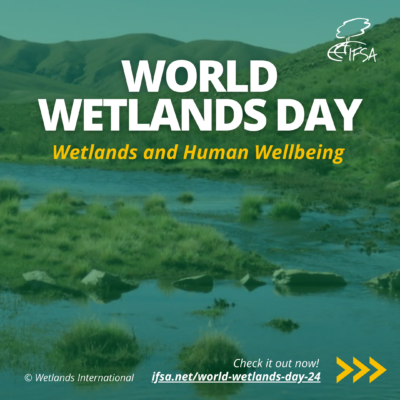
WORLD WETLANDS DAY
World Wetlands Day is observed on February 2 every year to raise global awareness about the importance of wetlands, not only for people but the planet Earth as well. This day also marks the date that the Convention on Wetlands on February 2, 1971 was adopted.
So what are wetlands? Wetlands are defined as a transition between terrestrial and aquatic ecosystems where the water table is usually either at or near the surface, or the land is covered by shallow water. We use the word wetland to refer to all areas which are covered periodically, seasonally, or permanently with water, such as: tidal flats, flooded areas near rivers, rice paddies, swamps or lakes (Kanaujia and Kumar, 2014). These lands are critical to people and nature, given the intrinsic value of these ecosystems. Their benefits and services include: environmental, climate, ecological, social, economic, scientific, educational, cultural, recreational and aesthetic contributions which greatly enhance human wellbeing and are incredibly important for sustainable development (United Nations, N.A).
Wetlands are in danger, being amongst the ecosystems with the highest rates of decline, loss, and degradation. Wetland loss is the loss of wetland area due to the conversion of wetland to non- wetland areas – a direct result of human activity such as the following factors: (Kanaujia and Kumar, 2014).
- Agricultural conversion
- Excessive citation
- Reclamation for development
- Climate change impact
Wetland degradation is the impairment of wetland functions as a result of human activity (Reduction in wetland functions)
- Reduced water quality
- Excessive biomass removal
- Introduction of exotic species
- Changes in the water regime
Wetlands Conservation
In his article, Gopal B (2020) highlighted that the conservation of wetlands, focused on protecting their biodiversity, specific biophysical characteristics, and maximizing benefits, necessitates a substantial policy shift concerning land and water use. Joining the Ramsar Convention is merely a step towards becoming part of the international community, expressing solidarity with its objectives.
- Both natural and human-made wetlands should be declared as a specific land use category and their hydrological characteristics.
- Prohibition of conversion to any other land use or any reduction in their area or alteration in their water regime
- The total biodiversity of all wetlands should be assessed and periodically monitored
- All ecosystem services of all wetlands should be assessed and valued in economic terms.
- All development projects such as those related to urban or industrial development, or those concerned with storage, diversion and abstraction of water from any source should consider all kinds of wetlands to be affected directly or indirectly, within the project area or far away from them.
References
Gopal B. 2020. Policy Brief: Wetland Conservation for Biodiversity and Ecosystem Services Needs a Shift in Land and Water Resources Policies. Delhi (IND):National Institute of Ecology.
Kanaujia A, Kumar A. 2014. Wetlands: Significance, Threats and their Conservation. Green 7(3): 1-23.
United Nations, N.A., Web: https://www.un.org/en/observances/world-wetlands-day